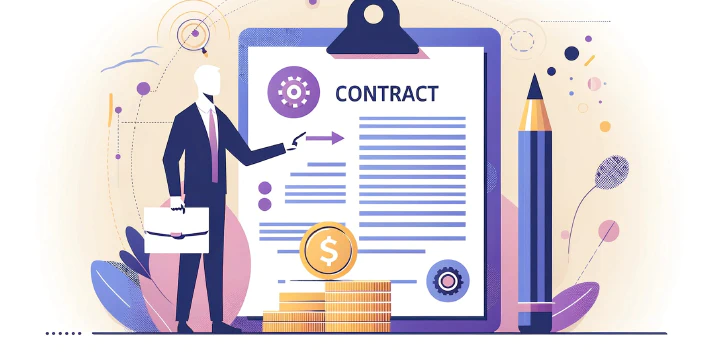Drawing up a contract: 9 steps to create an effective contract
A contract should clearly identify the parties, detail obligations, specify payment terms, outline duration and deadlines, include termination conditions, address dispute resolution, and provide signature lines for all parties. In this article, we’ll go through all the necessary steps to draw up a contract.
- Why are contracts so important?
- How to create a contract?
- 1. Contact information of both parties
- 2. Defining terms and scope of services
- 3. Define payment terms
- 4. Define schedule
- 5. Consequences of terminating the contract.
- 6. Determination of copyrights
- 7. Indication of choice of law and place of jurisdiction.
- 8. Consideration of arbitration clause.
- 9. Both parties must sign the contract

If you work with clients, you’re probably at least somewhat familiar with contract drafting. A contract is meant to address important details like the scope of the project, deliverables, payment, schedule and other contingencies - and to protect your company if any of those details are not met.
But how exactly do you do that? How do you create a contract that gets you and your client on the same page? And if your customer breaches the contract, how do you enforce the terms of the contract and make sure you protect your business?
Why are contracts so important?
First things first: before we get into how to create and enforce a contract, let’s look at why contracts are so important. Contracts are a must for your business for a number of reasons, including:
- They get you and your client on the same page: before working with a client, make sure you both have the same expectations for the relationship and the project.
- They clearly establish the key details of your working relationship: contracts help spell out the nitty-gritty details of the job (e.g., when the client must pay you and when you must deliver key project deliverables), creating a legal roadmap for how the project will unfold.
- You protect your business: Written contracts are legally binding documents - so if your client doesn’t abide by the terms of the contract, you can take legal action (and vice versa).
How to create a contract?
Draw up a contract using these 9 steps:
- Contact information of both parties
- Defining terms and scope of services
- Define payment terms
- Define schedule
- Consequences of terminating the contract
- Determination of copyrights
- Indication of choice of law and place of jurisdiction
- Consideration of the arbitration clause
- Both parties must sign the contract
Let’s go over each step.
1. Contact information of both parties
For a written contract to be legally binding, the contract creation process must clearly state who is legally bound by the agreement - in other words, you need contact information for all parties involved.
Each contract should include the legal name of the company, the main contact person, the address, the billing address and the contact details of both the customer and the contractor or client. Be sure to use your legal business name. For example, if you have formed a limited liability company, you must use the exact name that appears on the documents.
Use both your name and your client’s name throughout the creation of the agreement. If you use generic terms such as “customer,” “third party,” or “service provider” in the agreement, the contract will sound much more impersonal, which, while legally harmless, may put off some customers.
2. Defining terms and scope of services
As mentioned earlier, the main point of writing contracts is to outline the details of your agreement. It’s important to be as specific as possible about what you’ll be contracted to do, how you’ll do it, and what expectations both sides have.
For example, let’s say you’re creating a contract to design an informational brochure for a client. What is the scope of the project? Are you only responsible for the design or are you also responsible for writing the copy and sourcing images? What documentation do you need from the client to begin the project? How many revisions does the redesign include - and what happens if the client wants another round of revisions?
You can never be specific enough when creating a contract when outlining the details of the project. The goal is to set expectations and manage the working relationship with clear and predefined parameters. While it may seem excessive, it’s important for you and your clients to be specific about the details.
You don’t want to feel like you have to deliver more than you agreed, and you don’t want your customers to feel like they’re not getting what they paid for.
3. Define payment terms
When defining payment terms, consider the following areas when creating the contract:
- How you will be paid: Will you be paid by the hour or by the project?
- Minimum/Maximum Hours: If you will be paid by the hour, you should specify a minimum and maximum number of hours. This way, you will be paid for the time you have allotted to the project, even if your client cuts the project to a minimum. This will also prevent the scope of the project from increasing, and ensure fair compensation if your client decides to charge you for more work.
- Project deliverables: If you’re being paid per project, it’s important to specify what services you’re responsible for and what the project price actually covers - again, to prevent the scope of the project from expanding.
- Billing schedule: set not only your hourly or project rate, but also the billing schedule. For example, if you are paid by the hour, do you bill on a specific schedule (e.g., every week or every month)? If you bill by project, do you bill only after certain milestones are reached - and if so, what are they?
- Payment schedule: The billing schedule indicates when you will bill the customer, but you must also establish a payment schedule. The payment schedule indicates how long the customer has to pay you after receiving your invoice (e.g., 15 or 30 days). You also need to specify what penalties the customer will face if they don’t follow the payment plan, such as a late payment fee.
- Accepted payment types: If you only accept certain payment methods (e.g. a direct bank transfer), you should also include this in your contract.
4. Define schedule
In addition to billing and payment schedules, you should also clearly define all deadlines associated with the project when creating a contract, including project milestones and final deliverables. If the customer needs to provide something for the project, be specific about what you need from them and by when.
5. Consequences of terminating the contract.
Sometimes projects don’t go as you expect - but if your client decides to back out of the project and thus terminates the contract, you want to make sure your business is protected. And, of course, you want to be paid for the work you’ve already done. Keep this in mind when drafting the contract.
When drafting the contract, include a clause that clearly states that payments received will not be refunded if the project is terminated for any reason. This is especially important if you plan to invoice throughout the duration of the project. This way, you ensure that you don’t invest a lot of work only to have the client cancel the project and refuse to pay you.
You can also add wording that says if the project is delayed for a certain period of time (e.g., more than 30 days), you will invoice for all work done up to that point - and that this invoice must be paid according to the payment terms of the contract.
If you are billing per project, you should also include a “termination fee” - a fee that the client must pay (usually 25-35% of the project cost) if they decide to terminate the project early.
6. Determination of copyrights
While this does not apply to every business or client project, if you are creating work for a client such as a graphic or web design project, you should establish the copyright terms for the final deliverable and any previous drafts or compositions at the time of contract creation.
Generally, the service provider owns the rights to the work created until final payment is made. Once payment is made, those rights transfer to the client, who can then do whatever they want with the work. If you are concerned about copyrights or want to make some other arrangement, you should state this in your contract so that your client is comfortable with it before you begin.
7. Indication of choice of law and place of jurisdiction.
When creating the contract, specify where legal disputes will be litigated and what laws will apply to those disputes. This may be helpful if you and your customer are located in different states. Unless you have a specific reason for choosing a different state, simply choose your own state. That way, if a dispute arises, you won’t have to spend extra time, energy or money traveling to another state.
8. Consideration of arbitration clause.
Ideally, with a well-drafted contract, you will never face a contract dispute. However, if you do, you may want to settle it through arbitration - in which case you should include an arbitration clause in the contract. If there is a dispute related to the contract, a neutral third party will hear evidence from both sides and make a decision.
The advantage of arbitration? It’s usually faster, simpler and easier to schedule (though not necessarily cheaper) than a court case. It can also be less adversarial and more private than a court case. If you feel this is your preferred method of arbitration, consider including an arbitration clause in your contract.
Even if you do not consider an arbitration clause when drafting the contract, you may choose to use an arbitrator in the event of a dispute between you and your customer, provided you both agree. However, if the relationship between you and your customer has deteriorated, it may be difficult to agree on a common line.
9. Both parties must sign the contract
Contracts are only legally binding if they are signed by both parties. Once your contract is fully drafted, you should sign it and obtain a signature from your client before starting the project.
Contracts are important for setting your client’s expectations, outlining project details, and ensuring you get paid for your work. Now that you know how to create and enforce contracts, you have the information you need to protect your business rights.
Please keep in mind that none of the content on our blog should be considered legal advice. We understand the complexities and nuances of legal matters, and as much as we strive to ensure our information is accurate and useful, it cannot replace the personalized advice of a qualified legal professional.

Table of contents
- Why are contracts so important?
- How to create a contract?
- 1. Contact information of both parties
- 2. Defining terms and scope of services
- 3. Define payment terms
- 4. Define schedule
- 5. Consequences of terminating the contract.
- 6. Determination of copyrights
- 7. Indication of choice of law and place of jurisdiction.
- 8. Consideration of arbitration clause.
- 9. Both parties must sign the contract
Want product news and updates? Sign up for our newsletter.
Other posts in Contract Creation

The Best AI Contract Management Assistants for ChatGPT Users in 2025
In this article, we explore the top AI contract management tools for ChatGPT in 2025, tailored for SMEs …

Contract Creation: 8 Ways to optimize
There are many benefits to fully coordinating all contract management processes. By optimizing the contract …

Drawing up a contract: 9 steps to create an effective contract
A contract should clearly identify the parties, detail obligations, specify payment terms, outline duration …
Contracts can be enjoyable. Get started with fynk today.
Companies using fynk's contract management software get work done faster than ever before. Ready to give valuable time back to your team?
Schedule demo

